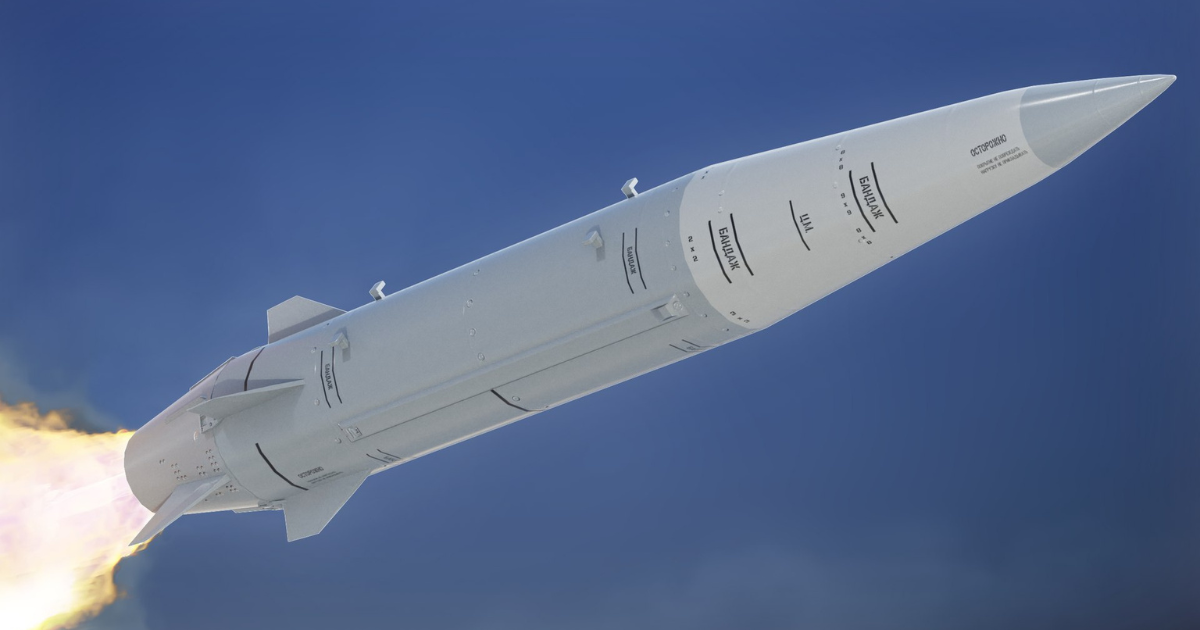The Kh-47M2 Kinzhal missile has emerged as a focal point of military discourse, touted as a Russian hypersonic air-launched ballistic missile with unparalleled capabilities. This analysis delves into the intricacies of the Kinzhal missile, scrutinizing various facets such as its technical specifications, purported hypersonic capabilities, cost implications, comparisons with other missiles, recent incidents involving the missile, and concerns from both Ukraine and NATO. Employing a neutral standpoint, we aim to dissect the facts and present a comprehensive understanding of this weapon system.
Kh-47M2 Kinzhal Missile Overview
The Kh-47M2 Kinzhal is a Russian hypersonic air-launched ballistic missile capable of carrying nuclear or conventional warheads. The name “Kinzhal” translates to “dagger” in Russian. So, Kinzhal Missile literally means “Dagger Missile” It has a reported range of 1,500-2,000 km (930-1,240 miles) while carrying a payload of 480 kg. The missile may reach speeds of up to Mach 10 (12,250 kph), making it a formidable tool in modern warfare. The fabrication of one Kh-47 Kinzhal hypersonic missile costs about US$10 million. The missile’s range is stated as 2,000 km (1,200 mi; 1,100 nmi) when carried by the MiG-31K and 3,000 km (1,900 mi; 1,600 nmi) when carried by the Tu-22M3. However, there are disputes regarding the missile’s actual speed and whether it truly qualifies as a hypersonic system.
| Specification | Value |
|---|---|
| Type | Hypersonic air-launched ballistic missile |
| Range | 1,500-2,000 km (930-1,240 miles) |
| Speed | Up to Mach 10 (12,250 kph) |
| Warhead Capacity | Nuclear or conventional warheads |
| Launch Altitude | About 18 km (59,000 ft) |
| Fabrication Cost | Approximately US$10 million |
| Length | 8 m |
| Diameter | 1 m |
| Launch Weight | Launch Weight Approximately 4,300 kg |
| Payload Capacity | 480 kg |
| Flight Trajectory | Erratic, limiting interception |
| Propulsion System | Rocket engine |
Cost and Complexity
The fabrication cost of a Kh-47M2 Kinzhal missile is approximately US$10 million. The complexity of the missile, particularly its rocket engine which necessitates carrying fuel and oxidant, significantly affects its range. This expense sets it apart from regular cruise missiles, reflecting its advanced technology and engineering complexity.
| Aspect | Value |
|---|---|
| Fabrication Cost | US$10 million |
| Cost of Six Launches | US$60 million |
| Comparative Expense | More expensive than regular cruise missiles |
However, the Kh-47M2 Kinzhal is notably more expensive than conventional cruise missiles, indicating its advanced and sophisticated nature.
Hypersonic Capability Analysis
The Kh-47M2 Kinzhal is presented as a Russian hypersonic air-launched ballistic missile, boasting a reported range of 1,500-2,000 km and speeds of up to Mach 10. However, experts question its true hypersonic status, noting that many ballistic missiles reach hypersonic speeds during their flight. This missile’s hypersonic feature does not represent a unique technological breakthrough, as it shares this characteristic with older designs.
| Aspect | Value |
|---|---|
| Hypersonic Speed | Up to Mach 10 |
| Flight Characteristics | High maneuverability, complicating interception |
| Technological Breakthrough | Questionable, shared feature with older designs |
Kinzhal Missle Comparison With Other Missiles
1- Kinzhal Vs Patriot Missile
The Kh-47M2 Kinzhal missile and the Patriot missile system have found themselves in a stark comparison, particularly during the recent conflict involving Ukraine. On May 4, 2023, Ukraine successfully utilized the U.S.-supplied Patriot battery to intercept a Russian Kinzhal missile, highlighting the Patriot system’s efficacy. The Kinzhal, a sophisticated Russian hypersonic missile, is purported to travel at astonishing speeds to evade air defenses.
However, its erratic flight trajectory and high maneuverability could present challenges for interception. Contrarily, the Patriot missile system, an advanced American-made defense mechanism, showcased its ability to intercept the Kinzhal, demonstrating its significance in countering such threats.
This successful interception not only highlighted the Patriot system’s effectiveness but also raised questions regarding the alleged hypersonic status of the Kinzhal missile, shedding light on the evolving dynamics of modern warfare and defense capabilities.
Here is a comparison table for the Kh-47M2 Kinzhal missile and the Patriot missile:
| Criteria | Kh-47M2 Kinzhal | Patriot Missile |
|---|---|---|
| Type | Air-launched ballistic missile | Surface-to-air missile defense system |
| Origin | Russia | United States |
| Range | 1,500-2,000 km | Short to medium range |
| Speed | Up to Mach 10 | Supersonic |
| Payload | 480 kg | N/A |
| Warhead | Nuclear or conventional | N/A |
| Intercepted by | U.S.-supplied Patriot battery | N/A |
| Success rate of interception | All six Kinzhal missiles intercepted | N/A |
| Cost | Much more expensive than regular cruise missiles | N/A |
| Technical complexity | Much more complicated than regular cruise missiles | N/A |
| Capabilities | Sophisticated Russian hypersonic missile | Advanced American-made missile defense system |
| Design | Air-launched ballistic missile | Surface-to-air missile defense system |
| Maneuverability | High | N/A |
| Flight trajectory | Erratic | N/A |
| Hypersonic status | Alleged hypersonic missile | Supersonic missile |
| Development | Unveiled by President Putin in 2018 | Developed by the United States |
| Use in Ukraine conflict | Fired by Russia | Used by Ukraine to intercept Kinzhal missiles |
| Reputation | Dismantled the tattered reputation of advanced Russian weapons | N/A |
Kh-47M2 Kinzhal Vs Zircon Missile
Here is a comparison table for the Kh-47M2 Kinzhal missile and the Zircon missile:
| Criteria | Kh-47M2 Kinzhal | Zircon Missile |
|---|---|---|
| Type | Air-launched ballistic missile | Hypersonic cruise missile |
| Origin | Russia | Russia |
| Range | 1,500-2,000 km | 500-1,000 km |
| Speed | Up to Mach 10 | Several times the speed of sound |
| Payload | 480 kg | N/A |
| Warhead | Nuclear or conventional | N/A |
| Intercepted by | U.S.-supplied Patriot battery | N/A |
| Success rate of interception | All six Kinzhal missiles intercepted | N/A |
| Cost | Much more expensive than regular cruise missiles | N/A |
| Technical complexity | Much more complicated than regular cruise missiles | N/A |
| Capabilities | Sophisticated Russian hypersonic missile | Next-generation hypersonic missile |
| Design | Air-launched ballistic missile | Hypersonic cruise missile |
| Maneuverability | High | High |
| Flight trajectory | Erratic | N/A |
| Hypersonic status | Alleged hypersonic missile | Hypersonic missile |
| Development | Unveiled by President Putin in 2018 | Developed by Russia |
| Use in Ukraine conflict | Fired by Russia | Allegedly deployed by Russia in the conflict |
| Reputation | Dismantled the tattered reputation of advanced Russian weapons | Leading the race to develop new hypersonic weapons |
| Plasma cloud | Covers the missile during flight, making it invisible to radars | Covers the missile during flight, making it invisible to radars |
| Target | Air-launched missile | Ground-launched missile |
| Test results | Intercepted by Patriot missile system | Successfully tested by Russia |
| Speed of sound | Up to Mach 10 (12,250 kph) | Several times the speed of sound |
| Range of missile | 1,500-2,000 km | 500-1,000 km |
| Maneuvering | High | High |
| Flight altitude | 18 km (59,000 ft) | N/A |
| Plasma cloud feature | Valuable feature | Valuable feature |
3- Kh-47M2 Kinzhal Vs BrahMos Missile
Here is a comparison table for the Kh-47M2 Kinzhal missile and the BrahMos missile:
| Criteria | Kh-47M2 Kinzhal | BrahMos Missile |
|---|---|---|
| Type | Air-launched ballistic missile | Supersonic cruise missile |
| Origin | Russia | Joint venture between India and Russia |
| Range | 1,500-2,000 km | 290 km |
| Speed | Up to Mach 10 | More than 5 Mach |
| Payload | 480 kg | N/A |
| Warhead | Nuclear or conventional | N/A |
| Intercepted by | U.S.-supplied Patriot battery | N/A |
| Success rate of interception | All six Kinzhal missiles intercepted | N/A |
| Cost | Much more expensive than regular cruise missiles | N/A |
| Technical complexity | Much more complicated than regular cruise missiles | N/A |
| Capabilities | Sophisticated Russian hypersonic missile | Versatile supersonic cruise missile |
| Design | Air-launched ballistic missile | Supersonic cruise missile |
| Maneuverability | High | N/A |
| Flight trajectory | Erratic | N/A |
| Hypersonic status | Alleged hypersonic missile | Supersonic missile |
| Development | Unveiled by President Putin in 2018 | Joint venture between India and Russia |
| Use in Ukraine conflict | Fired by Russia | N/A |
| Reputation | Dismantled the tattered reputation of advanced Russian weapons | Successful joint venture between India and Russia |
| Status of development | In service | BrahMos II faces significant delays |
| Range of missile | 1,500-2,000 km | 290 km |
| Speed of missile | Up to Mach 10 (12,250 kph) | More than 5 Mach |
| Maneuvering | High | N/A |
Military Involvement of Kinzhal Missile
The ongoing conflict between Russia and Ukraine has witnessed the utilization of the Kh-47M2 Kinzhal missile by Russian forces. On May 4, 2023, Ukraine effectively employed a U.S.-supplied Patriot battery to intercept a Russian Kinzhal missile, showcasing the importance of advanced defense systems.
Ukraine further claimed to have successfully downed all six Kinzhal missiles fired by Russia on May 16, 2023. However, the Ukrainian military has acknowledged the limitations of their air defenses in countering the Kinzhal, a sophisticated hypersonic missile renowned for its capability to evade air defenses through rapid travel at speeds up to ten times the speed of sound.
Despite the Kinzhal’s alleged hypersonic status being questioned, it remains a powerful air-launched ballistic missile capable of carrying nuclear or conventional warheads, maneuvering across its flight path, breaching defenses, and striking targets at distances exceeding 2,000 km. Its deployment in the conflict has played a role in reshaping perspectives on modern warfare, challenging the effectiveness of existing defense mechanisms and fostering technological advancements in the arms race.
Concerns and International Reactions
The utilization of the Kh-47M2 Kinzhal missile by Russia has sparked significant concern and reactions from the United States and the international community. The US, in particular, has expressed alarm over the capabilities of the Kinzhal missile.
As early as 2018, the US State Department emphasized the threat posed to US national security by Russia’s development of hypersonic weapons, pinpointing the Kinzhal missile as a notable concern. This worry was further amplified in May 2023 when the US condemned Russia’s use of the Kinzhal missile against Ukraine, urging an end to the aggression.
In response to Russia and China’s advancements in hypersonic weaponry, the US has proactively developed its own hypersonic weapons, such as the AGM-183A Air-launched Rapid Response Weapon (ARRW) and the Hypersonic Conventional Strike Weapon (HCSW).
Collaboratively, the US and its allies, including NATO, are striving to formulate a unified approach to counter the threat of hypersonic weapons, prominently featuring the Kinzhal missile. The alleged hypersonic status of the Kinzhal missile, its potential to evade air defenses, and its capacity to carry nuclear warheads have raised concerns, prompting the US to urge Russia to engage in arms control discussions aimed at addressing these mounting threats.
The international community is closely monitoring and strategizing responses to the evolving dynamics of hypersonic technology and its implications for global security.
Can Kinzhal Missiles be intercepted?
The Kh-47M2 Kinzhal missile presents a significant challenge for interception due to its high speed and maneuverability. Its ability to travel at speeds up to ten times the speed of sound and follow an erratic flight trajectory makes it a complex target for interception systems. The Ukrainian military, in particular, has acknowledged its incapability to shoot down Russian Kinzhal hypersonic missiles, underscoring the difficulty in intercepting these advanced missiles.
However, there are nuances to consider. Analysts have raised questions about the Kinzhal’s true capabilities, especially during the final phase of its flight. Some doubts have been cast on whether it’s as maneuverable or as fast as initially advertised, suggesting that there may be limitations to its full potential.
Notably, the U.S.-supplied Patriot system successfully intercepted a Kinzhal missile, demonstrating that interception is possible. However, it’s crucial to recognize that the Patriot system was designed before hypersonic weapons were widely deployed, and there hasn’t been explicit public confirmation regarding its effectiveness against missiles flying at hypersonic speeds.
The designation of the Kinzhal missile as “hypersonic” has also been scrutinized. The Center for Strategic and International Studies highlighted that nearly all ballistic missiles reach hypersonic speeds at some point during their flight, adding a layer of complexity in determining the true extent of the Kinzhal’s hypersonic capabilities.
The Kinzhal missile’s high speed and maneuverability indeed pose challenges for interception. Despite successful intercepts, such as those by the U.S.-supplied Patriot system, the overall effectiveness of existing defense systems against hypersonic missiles like Kinzhal remains a subject of ongoing evaluation and development. In short, To stop the Kinzhal missile, intercepting its erratic flight trajectory and high maneuverability is essential.
Final Words
The analysis of the Kh-47M2 Kinzhal missile has brought to light a nuanced perspective, steering through a plethora of statistics, comparisons, and contextual considerations. While the Kinzhal missile’s purported hypersonic prowess captures attention, it’s essential to consider the concrete details and contextual realities that temper these claims. The landscape of modern warfare is continually evolving, and within it, understanding the dynamics of weapons like the Kinzhal missile is crucial for a balanced appraisal of global security scenarios. As developments unfold and technology advances, maintaining an informed and discerning perspective remains paramount in navigating the complexities of the global defense landscape.






